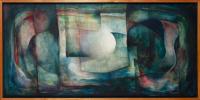Estimate: $9,000/$12,000
Ernest Philpot was a trailblazer in the Western Australian art scene,
recognized as the first exponent of non-objective abstract painting in the
state. While he wasn’t known for being a social butterfly or a fixture at
parties, he found deep fulfillment in the solitude of his studio, immersed
in his work and often limiting his palette to a restrained selection of
colours.
...
Born in England in 1906, Philpot emigrated to Western Australia with his
family in 1913. At a time when artists in the region found it difficult to
sustain a livelihood through art alone, Philpot defied convention,
embracing abstraction long before it gained widespread acceptance.
In search of a broader audience and critical recognition, Philpot held a
solo retrospective exhibition in London during the winter of 1960–1961.
Hosted at The Commonwealth Institute in Kensington, the show presented a
body of work spanning three decades—from traditional early pieces to his
evolution into abstraction. Though the exhibition was a significant
milestone, his efforts to establish a presence in the London art world were
hampered by his lack of familiarity with the British art market and its
expectations. His aspirations for international acclaim went largely
unfulfilled, leaving him disheartened.
Philpot led a rich and varied life beyond the canvas. He studied at the
National Gallery School in Victoria, served as a field surveyor with the
Australian Army during World War II, and played the euphonium in a
Salvation Army brass band. His talents were acknowledged with awards
including the Claude Hotchin Painting Prize in 1948 and the Art Gallery of
Western Australia Prize for Oil Painting in 1952.
Throughout his career, Philpot remained a committed member of the local art
community, regularly exhibiting with the Perth Society of Artists. He also
managed a signwriting business he inherited from his uncle in 1937. In
1957, he sold the business and took up a position as an art master at
Wesley College, where he taught until his retirement in 1968. During this
time, he also served as an art critic for the Perth Sunday Times from 1961
to 1965.
This work,“No Ultimate Reality”, is one of the largest pieces he
worked on and exemplifies his commitment to pure abstraction. The painting
analyses the fundamental elements of visual language—shape, colour, and
texture—in a way that challenged conventional art norms of the time. While
such work is now distinguished, it was initially met with uncertainty in
conservative 1960s Perth. Still, Philpot remained steadfast in his artistic
convictions, undeterred by public opinion.
A key factor that enabled Philpot to remain true to his artistic vision was
his financial independence. Free from the pressure to produce commercially
viable work, he was able to explore uncharted creative territory on his own
terms.
Today, Ernest Sidney Philpot’s contributions to Australian modernism are
widely recognized. His works are held in prominent collections including
the Art Gallery of Western Australia, the University of Western Australia,
the National Gallery of Australia, and numerous regional and private
collections across the country. His legacy endures as a testament to
artistic courage, innovation, and integrity.
Read more


